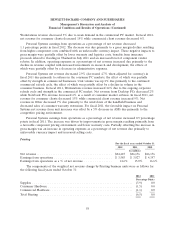HP 2012 Annual Report Download - page 75
Download and view the complete annual report
Please find page 75 of the 2012 HP annual report below. You can navigate through the pages in the report by either clicking on the pages listed below, or by using the keyword search tool below to find specific information within the annual report.
HEWLETT-PACKARD COMPANY AND SUBSIDIARIES
Management’s Discussion and Analysis of
Financial Condition and Results of Operations (Continued)
Operating Activities
Net cash provided by operating activities decreased by approximately $2.1 billion for fiscal 2012 as
compared to fiscal 2011. The decrease was due primarily to lower net earnings and higher utilization of
cash resources for payment of accounts payable, the impact of which was partially offset by lower
investment in inventory and higher cash generated from collections of accounts and financing
receivables. Net cash provided by operating activities increased by approximately $0.7 billion for fiscal
2011 as compared to fiscal 2010. The increase was due primarily to higher cash generated through the
utilization of operating assets, primarily accounts and financing receivables, and lower utilization of
cash resources for payment of accounts payable, the impact of which was partially offset by decreases in
net earnings and cash utilized as a result of higher inventory levels.
Our key working capital metrics are as follows:
October 31
2012 2011 2010
Days of sales outstanding in accounts receivable ........................... 49 51 50
Days of supply in inventory .......................................... 25 27 23
Days of purchases outstanding in accounts payable ......................... (53) (52) (52)
Cash conversion cycle .............................................. 21 26 21
Days of sales outstanding in accounts receivable (‘‘DSO’’) measures the average number of days
our receivables are outstanding. DSO is calculated by dividing ending accounts receivable, net of
allowance for doubtful accounts, by a 90-day average net revenue. Our accounts receivable balance was
$16.4 billion as of October 31, 2012.
Days of supply in inventory (‘‘DOS’’) measures the average number of days from procurement to
sale of our product. DOS is calculated by dividing ending inventory by a 90-day average cost of goods
sold. Our inventory balance was $6.3 billion as of October 31, 2012.
Days of purchases outstanding in accounts payable (‘‘DPO’’) measures the average number of days
our accounts payable balances are outstanding. DPO is calculated by dividing ending accounts payable
by a 90-day average cost of goods sold. Our accounts payable balance was $13.4 billion as of
October 31, 2012.
Our working capital requirements depend upon our effective management of the cash conversion
cycle, which represents effectively the number of days that elapse from the day we pay for the purchase
of raw materials to the collection of cash from our customers. The cash conversion cycle is the sum of
DSO and DOS less DPO.
The cash conversion cycle for fiscal 2012 decreased by five days compared to fiscal 2011. The
decrease in DSO was due primarily to improved collections, an increase in cash discounts and a decline
in extended payment terms. Additionally our DSO benefited from the current-period DSO calculation
containing a full quarter of revenue from our Autonomy acquisition versus the approximately one
month of revenue that was included in the prior-period DSO calculation. These favorable impacts to
DSO were partially offset by revenue linearity. The decrease in DOS was due to lower inventory
balances in most segments as of October 31, 2012. The increase in DPO was primarily due to improved
purchasing linearity.
67
























